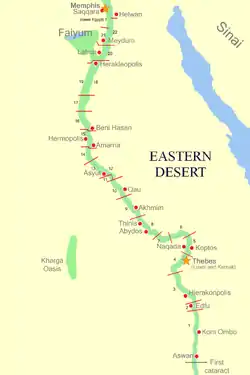Ta-Seti
Ta-Seti (Land of the bow, also Ta Khentit, the Frontier or Borderland) was the first nome (administrative division) of Upper Egypt, one of 42 nomoi in Ancient Egypt.[1][2][3][4][5][6] Ta-Seti marked the border area towards Nubia, and the name was also used to refer to Nubia itself.[7][8][9][10]
| Ta-Seti in hieroglyphs |
|---|
_1up.jpg.webp)

History
Every nome was ruled by a nomarch (provincial governor), who answered directly to the pharaoh.[2][3][4][5]
The area of the district was about 2 cha-ta (about 5.5 hectare / 4.8 acres; 1 cha-ta equals roughly 2.75 hectare / 2.4 acres) and about 10,5 iteru (about 112 km / 69,6 miles, 1 iteru equals roughly 10,5 km / 6.2 miles) in length.[11]
The Niwt (main city) was Abu / Elephantine (part of modern Aswan) and among other cities were P'aaleq / Philae (modern Philae), Sunet / Syene (modern Aswan) and Pa-Sebek / Omboi (modern Kom Ombo).[2][3][4][5][6] Every niwt had a Het net (temple) dedicated to the chief deity and a Heqa het (nomarchs residence).[1]
The district's main deity was Horus and among others major deities were Anuket, Arensnuphis, Hathor, Isis, Khnum, Mandulis, Satet and Sobek.[2][3][4][5][6] Today the area is part of the Aswan Governorate.
The Ta-Seti people and their identity is still trying to be deciphered. Today, from what is known they are believed to have spoken a Nilo-Saharan language.[12]
Nomarchs of Ta-Seti
The following is a partial genealogy of the nomarchs of Ta-Seti during the 12th Dynasty. The nomarchs are underlined.[13]
| Sarenput I | Khema | Satethotep♀ | |||||||||||||||||||||||||||||||||||||||||||||||
| Sarenput II | Shemai | ||||||||||||||||||||||||||||||||||||||||||||||||
| Sat-tjeni♀ | |||||||||||||||||||||||||||||||||||||||||||||||||
| Heqaib III | Amenyseneb | ||||||||||||||||||||||||||||||||||||||||||||||||
References
- "Archived copy". Archived from the original on 2010-12-09. Retrieved 2010-07-14.CS1 maint: archived copy as title (link), Egypt Ancient.net, accessdate=2010-07-14
- , Egypt tourist authority, accessdate=2010-07-14
- "Archived copy". Archived from the original on 2010-06-02. Retrieved 2010-07-14.CS1 maint: archived copy as title (link), Ancient Egyptian religion, Philae.net, accessdate=2010-07-14
- , Reshafim.org, accessdate=2010-07-14
- , Aldokan.com, accessdate=2010-07-14
- , Digital Egypt for Universities, accessdate=2010-07-14
- Ancient Nubia: A-Group 3800–3100 BC
- Ancient Nubia: A Brief History. livescience.com
- The Fitzwilliam Museum: Kemet
- Newton, Steven H. (1993). "An Updated Working Chronology of Predynastic and Archaic Kemet". Journal of Black Studies. 23 (3): 403–415. doi:10.1177/002193479302300308. JSTOR 2784576. S2CID 144479624.
- , Faszination Ägypten (in German), accessdate=2010-07-14
- Christopher Ehret, The Civilizations of Africa: A History to 1800, University Press of Virginia, 2002.
- "Burial chamber discovered". Ahram Weekly. Retrieved 2017-03-25.
- Helck, Wolfgang; Westendorf, Wolfhart: Lexikon der Ägyptologie. Wiesbaden: Harrassowitz 1977. ISBN 3-447-01876-3